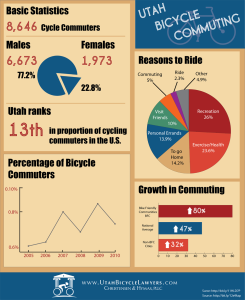 Congratulations on your desire for a healthy, happy habit of riding your bicycle to work! Here are some tips from The UDOT UTah Bicycle Commuter Guide for making sure your bike is both properly outfitted for the road ahead (no pun intended).
Congratulations on your desire for a healthy, happy habit of riding your bicycle to work! Here are some tips from The UDOT UTah Bicycle Commuter Guide for making sure your bike is both properly outfitted for the road ahead (no pun intended).
Your first priority is to safety. If you are safe, that makes other vehicles more aware, and the whole commute is much more enjoyable. It’s important to get proper outfitting for your bike in low-light situations, and overtime the fuel expenses you are saving will more than make up for the additional accessories.
Lights and Reflectors:
Utah law requires headlights (a white headlight visible for 500 feet), rear lights, or reflectors in low light riding. There are three main types of bicycle lights:
- non-rechargeable–inexpensive initially, but the cost of batteries compile, as does the hazardous waste from used ones.
- Rechargeable–initially more expensive, but the cost is offset by the fact that you don’t need to replace the batteries–and you don’t put waste into landfills!
- Generator-powered–no batteries required. It is lower-light admittance, and they will only produce light when the bike is in motion. (It is safer to be visible, even when stopped).
It is a very good idea to keep a spare headlight with you on nights of commuting. This will be useful in case you forget your main light, or if the batteries die, or if there is another mechanical failure. You’ll want the spare light to be able to attach to your bike or your person.
When riding at night, proper lights are imperative. Blinking rear red lights are effective, but not always a suitable substitute for a reflector. If you only use the red light, check with your local bike shop that it complies with state laws as a reflector. The best idea is to use both a rear light and reflectors. Reflectors rely on oncoming light to function, and sometimes lights can be angled inadequately for proper reflection, or aimed in a different direction, etc. A rear light can fail too, with electronic, mechanical, or battery failure. So it’s better to cover your bases, and outfit your bike with both.
It’s a great idea to add extra reflective tape on your person, or your helmet, for extra visibility. Better safely visible than sorry!
Repairs:
It is a good thing to be prepared for some basic repairs when riding. A basic tool kit with a small set of allen wrenches, a tire patch kit, and tire levers, is probably everything you’ll need. Maybe even connect a pump to your bike frame in case your tire goes flat. Ask your local bike shop about puncture-resistant tires and tubes, liquid sealants, or tire liners, to help prevent flat tires. Of course the grease and oil can always get a little messy, so you might want to have a rag handy in your kit to clean up your hands after any repairs.
Fenders:
In wet cycling conditions, fenders are invaluable to any biker. They will keep the spray from wheels off of your legs and clothes. This will keep you dryer, cleaner, and more comfortable. They will also keep your bike clean–at least, cleaner–and will reduce maintenance problems from rain. The more coverage of the wheel, the better.
Mirrors:
You might have thought that rear-view mirrors belong on a car, but they can also be very practical on a bike. If you’re traveling along high-traffic areas, being aware of the vehicles behind you is a very good thing. They can come mounted on either your helmet or your bars. There are pros and cons to both. They can be distracting, or sometimes they can shake around, but they are better than not. However if you use a mirror, it is not a substitute for looking behind you, especially when turning, changing lanes, or passing.
Of course it’s always a great idea to have a cell phone on you, just in case of an emergency.
Keep yourself visible, prepared, and SAFE as your riding the noble commute to and from work this season.
Image courtesy of Richard Masoner
